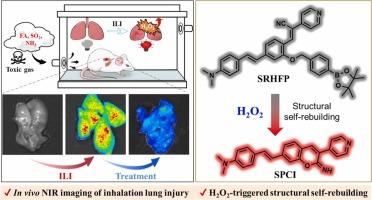过氧化氢响应型近红外荧光探针的构建及其在吸入性肺损伤追踪中的生物学应用
IF 3.7
1区 化学
Q1 CHEMISTRY, ANALYTICAL
引用次数: 0
摘要
吸入性肺损伤(ILI)是一种炎症驱动的疾病,主要由氧化应激介导。因此,识别氧化应激相关因素对ILI的早期诊断和及时干预至关重要。过氧化氢(H2O2)是一种重要的活性氧(ROS),已被证明在ILI的发生和发展中起关键调节作用,其水平动态反映氧化应激的程度。利用荧光成像技术选择性检测H2O2是一种很有前途的ILI检测方法。本文基于H2O2触发的结构自重建过程,包括连续三步氧化、自焚和共价键组装,开发了用于实时监测H2O2的荧光探针SRHFP。SRHFP具有良好的光学特性,如生理条件下0.1 μM的低检出限,660 nm中心的近红外发射带避免了组织自身荧光,230 nm的大Stokes位移最大限度地减少了荧光的自猝灭,以及出色的稳定性。探针SRHFP能够灵敏地监测A549细胞内源性和外源性H2O2,准确检测各种有毒化学气体诱导的肺损伤模型细胞。此外,SRHFP具有肺部优先积累的特点,并成功应用于监测吸入有毒气体引起的ILI模型小鼠肺部H2O2升高和地塞米松处理小鼠H2O2浓度降低,证实H2O2水平与ILI病理过程有较强的相关性。该探针能够实现ILI进展的动态可视化,并具有作为炎症相关肺部疾病诊断工具的重大潜力。本文章由计算机程序翻译,如有差异,请以英文原文为准。

Construction of a hydrogen peroxide-responsive near-infrared fluorescent probe and the biological application in tracking inhalation lung injury
Inhalation lung injury (ILI) is an inflammation-driven disease primarily mediated by oxidative stress. Accordingly identifying oxidative stress-related factors is crucial for early diagnosis and timely intervention of ILI. Hydrogen peroxide (H2O2), one of the important reactive oxygen species (ROS), has been shown to be a key regulator in the onset and progression of ILI, with its levels dynamically reflecting the extent of oxidative stress. The selective detection of H2O2 using fluorescence imaging technology is a promising method for ILI detection. Herein, the fluorescent probe SRHFP based on a H2O2-triggered structural self-rebuilding procedure including successive three-step oxidation, self-immolation and covalent bond assembly has been developed for real-time H2O2 monitoring. SRHFP performs the advantageous optical properties, such as low detection limit of 0.1 μM under physiological conditions, NIR emission band centered at 660 nm to avoid tissue autofluorescence, large Stokes shift of 230 nm to minimize fluorescence self-quenching, and remarkable stability. Probe SRHFP has capability of sensitively monitoring both endogenous and exogenous H2O2 in A549 cells and accurately detecting various toxic chemical gases-induced lung injury model cells. What’s more, SRHFP possesses the characteristic of priority lung accumulation and was successfully applied to monitor the H2O2 elevation in the lungs of ILI model mice induced by inhalation of toxic gas and the decrease of H2O2 concentration in dexamethasone-treated mice, confirming the strong correlation between H2O2 levels and ILI pathological process. This probe enables dynamic visualization of ILI progression and holds significant potential as a diagnostic tool for inflammation-related lung diseases.
求助全文
通过发布文献求助,成功后即可免费获取论文全文。
去求助
来源期刊

Sensors and Actuators B: Chemical
工程技术-电化学
CiteScore
14.60
自引率
11.90%
发文量
1776
审稿时长
3.2 months
期刊介绍:
Sensors & Actuators, B: Chemical is an international journal focused on the research and development of chemical transducers. It covers chemical sensors and biosensors, chemical actuators, and analytical microsystems. The journal is interdisciplinary, aiming to publish original works showcasing substantial advancements beyond the current state of the art in these fields, with practical applicability to solving meaningful analytical problems. Review articles are accepted by invitation from an Editor of the journal.
 求助内容:
求助内容: 应助结果提醒方式:
应助结果提醒方式:


